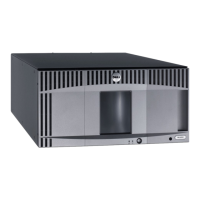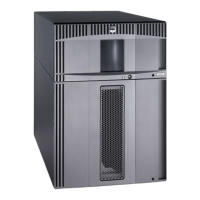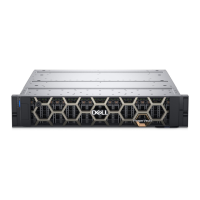Configuring Your Library
file:///T|/htdocs/stor-sys/ML6000/en/html/ch04.htm[9/17/2012 1:49:29 PM]
• Changing channel zoning setting will cause the affected FC I/O blade to reboot.
• If host port failover is enabled on the FC I/O blade, channel zoning must be configured so that all target FC ports have
access to all initiator ports. For information on host port failover, see
Configuring FC Host Port Failover.
• The Setup - I/O Blade Channel Zoning screen on the Web client lists all FC I/O blades found in the library. FC I/O
blades are listed by the following: location in the library, WWNN, and status. The corresponding Channel Zoning
Select Blade screen on the operator panel lists the location in the library and state. You can select the I/O blade you
want to configure for channel zoning and proceed to the next screen.
• The two FC target ports (ports 1 and 2) and the four FC initiator ports (ports 3–6) are displayed in a grid, with the
target ports listed in columns and the initiator ports listed in rows. Check boxes allow you to associate a target port
with an initiator port.
• To permit access, select the check box at the intersection of the target port and the initiator port. You can
associate each initiator port with more than one target port.
• To restrict access, clear the check box at the intersection of the target port and the initiator port.
• When you select a check box, the entire FC channel is zoned. This zoning affects any host application that might
be accessing the I/O blade. If both channel zoning and host mapping are enabled, the channel zoning settings
supersede any host LUN mapping on the I/O blade.
• After configuring channel zoning, save the library configuration. For instructions on how to save the library
configuration, see
Saving and Restoring the Library Configuration.
Note: This operation should not be performed concurrently by multiple administrators logged in from different
locations. You can access the appropriate screens, but you cannot apply changes while another administrator is
performing the same operation.
The paths to open the appropriate screens are as follows:
• From the Web client, select Setup > I/O Blades > Channel Zoning.
• From the operator panel, select Setup > I/O Blades > Channel Zoning.
Managing FC Hosts and Host Mapping
An FC host is the main processing server on a storage area network (SAN) that receives data and initiates communication
with other devices. When FC I/O blades are installed in the library, administrators can access, add, modify, and delete FC
hosts and also configure FC host mapping. Before you can perform any of these FC host management operations, you need to
enable host mapping, which is disabled by default. See
Enabling/Disabling FC Host Mapping.
Note: On the operator panel, the host management screens (Setup >
I/O Blades > Host Management) are not available unless FC host mapping is enabled.
Note: If both channel zoning and host mapping are enabled, the channel zoning settings supersede any host LUN
mapping on the I/O blade.
Enabling/Disabling FC Host Mapping
Administrators can enable or disable the optional FC host mapping feature. This feature is disabled by default. When host
mapping is enabled, you can add, modify, and delete hosts as well as configure FC host mapping.
Note: This operation should not be performed concurrently by multiple administrators logged in from different
locations. You can access the appropriate screens, but you cannot apply changes while another administrator is
performing the same operation.
The paths to open the appropriate screens are as follows:
• From the Web client select Setup > I/O Blades > I/O Blade Control.
• From the operator panel, select Setup > I/O Blades > Blade Control.
Viewing FC Host information
The following information is provided for FC hosts:
• Host Name — The host device name

